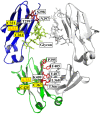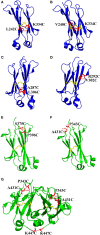Engineering of Fc Fragments with Optimized Physicochemical Properties Implying Improvement of Clinical Potentials for Fc-Based Therapeutics
- PMID: 29375551
- PMCID: PMC5766897
- DOI: 10.3389/fimmu.2017.01860
Engineering of Fc Fragments with Optimized Physicochemical Properties Implying Improvement of Clinical Potentials for Fc-Based Therapeutics
Abstract
Therapeutic monoclonal antibodies and Fc-fusion proteins are successfully used in treatment of various diseases mainly including cancer, immune disease, and viral infection, which belong to the Fc-based therapeutics. In recent years, engineered Fc-derived antibody domains have also shown potential for Fc-based therapeutics. To increase the druggability of Fc-based therapeutic candidates, many efforts have been made in optimizing physicochemical properties and functions mediated by Fc fragment. The desired result is that we can simultaneously obtain Fc variants with increased physicochemical properties in vitro and capacity of mediating appropriate functions in vivo. However, changes of physicochemical properties of Fc may result in alternation of Fc-mediated functions and vice versa, which leads to undesired outcomes for further development of Fc-based therapeutics. Therefore, whether modified Fc fragments are suitable for achievement of expected clinical results or not needs to be seriously considered. Now, this question comes to be noticed and should be figured out to make better translation from the results of laboratory into clinical applications. In this review, we summarize different strategies on engineering physicochemical properties of Fc, and preliminarily elucidate the relationships between modified Fc in vitro and the subsequent therapeutic influence in vivo.
Keywords: Fc-based therapeutics; Fc-fusion protein; aggregation; monoclonal antibody; optimization; physicochemical property; stability.
Figures





Similar articles
-
Optimization on Fc for Improvement of Stability and Aggregation Resistance.Curr Pharm Biotechnol. 2016;17(15):1353-1359. doi: 10.2174/1389201017666161117145312. Curr Pharm Biotechnol. 2016. PMID: 27855600
-
IgG Fc Fragment as a Scaffold for Development of Targeted Therapeutics.Curr Pharm Biotechnol. 2016;17(15):1315-1323. doi: 10.2174/1389201018666161114152527. Curr Pharm Biotechnol. 2016. PMID: 27842481
-
Optimizing therapeutic antibody function: progress with Fc domain engineering.BioDrugs. 2011 Feb 1;25(1):1-11. doi: 10.2165/11537830-000000000-00000. BioDrugs. 2011. PMID: 21033767 Review.
-
Fc fusion as a platform technology: potential for modulating immunogenicity.Trends Biotechnol. 2015 Jan;33(1):27-34. doi: 10.1016/j.tibtech.2014.11.001. Epub 2014 Dec 6. Trends Biotechnol. 2015. PMID: 25488117 Review.
-
New Directions for Half-Life Extension of Protein Therapeutics: The Rise of Antibody Fc Domains and Fragments.Curr Pharm Biotechnol. 2016;17(15):1348-1352. doi: 10.2174/1389201017666160823144032. Curr Pharm Biotechnol. 2016. PMID: 27552847
Cited by
-
Novel modular chimeric antigen receptor spacer for T cells derived from signal regulatory protein alpha Ig-like domains.Front Mol Med. 2022 Dec 13;2:1049580. doi: 10.3389/fmmed.2022.1049580. eCollection 2022. Front Mol Med. 2022. PMID: 39086976 Free PMC article.
-
Druggability properties of a L309K mutation in the antibody CH2 domain.3 Biotech. 2024 Jun;14(6):152. doi: 10.1007/s13205-024-04000-y. Epub 2024 May 11. 3 Biotech. 2024. PMID: 38742229
-
Next generation of multispecific antibody engineering.Antib Ther. 2023 Dec 8;7(1):37-52. doi: 10.1093/abt/tbad027. eCollection 2024 Jan. Antib Ther. 2023. PMID: 38235376 Review.
-
Immunogenicity of a recombinant plant-produced respiratory syncytial virus F subunit vaccine in mice.Biotechnol Rep (Amst). 2023 Dec 23;41:e00826. doi: 10.1016/j.btre.2023.e00826. eCollection 2024 Mar. Biotechnol Rep (Amst). 2023. PMID: 38234330 Free PMC article.
-
Effects of Two Soluble ACE2-Fc Variants on Blood Pressure and Albuminuria in Hypertensive Mice: Research Letter.Can J Kidney Health Dis. 2023 Oct 23;10:20543581231207146. doi: 10.1177/20543581231207146. eCollection 2023. Can J Kidney Health Dis. 2023. PMID: 37881406 Free PMC article.
References
Publication types
LinkOut - more resources
Full Text Sources
Other Literature Sources


